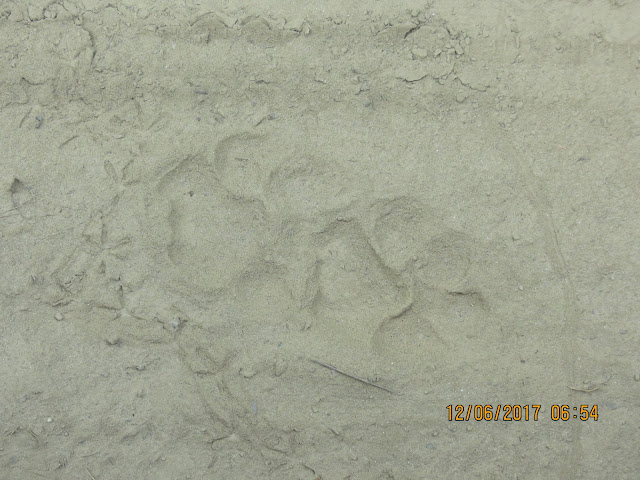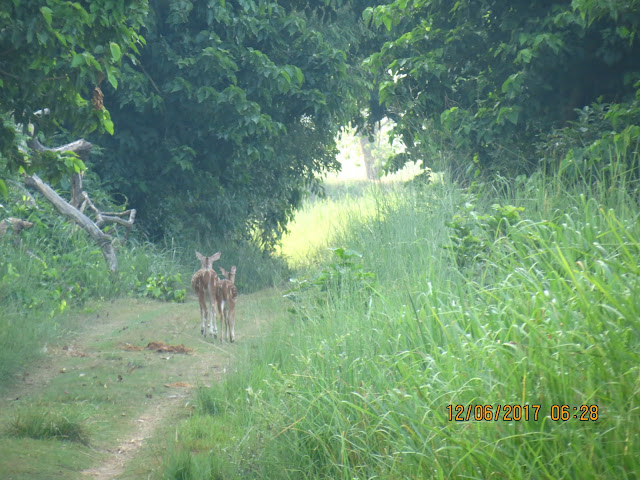Besides history and historical places, my
other love is jungles and wildlife. After visiting some of the very beautiful
and fascinating jungles in south (e.g. Bandipur, Nagarhole, Dandeli-Anshi,
Silent Valley, Pambikulam, Top Slip etc.), It was time to explore some in
North.
 |
| Entering into Dudhwa reserve forests |
 |
| Watch Tower at forest guest house |
 |
| Forest Guest House, Dudhwa |
There is excellent lodging facility
available through UP Eco Tourism. I booked a room through them. It can be done
online.
The area was established in 1958 as a wildlife sanctuary for swamp deer. Thanks to the efforts of Billy Arjan Singh, the area was notified as a national park in January 1977 and a tiger reserve in 1987.
The route to Dudhwais via Lucknow – Sitapur
– LakhimPur – Palia – Dudhwa.
We started early morning at around 7 AM from Lucknow. Total distance of about 220 KMs took around 4 hours.
We started early morning at around 7 AM from Lucknow. Total distance of about 220 KMs took around 4 hours.
Drive was good overall. The road is not
that good after Sitapur. Need to take care not to enter Sitapur city. A few KMs
before it, take right turn to go to Lakhimpur and then towards Palia.
 |
| Getting lost.... |
The park's dense forest along with
grasslands is characteristic of the Terai ecosystems and the area is, probably,
the last prominent remnant of this type of ecosystem. The grasslands comprise
about 19% of the park. The wetlands constitute the third major habitat type and
include the rivers, streams, lakes and marshes.
We took late breakfast and after relaxing
for some time, started exploring the surroundings.
The UP Eco Tourism Lodge is nice place to
hang around. It has quite good watch towers and also a small museum to keep
tourists engaged.
 |
| The Jungle Fowl |
In the mid-1980s, Indian rhinoceros was
reintroduced into Dudhwa from Assam and Nepal. The grasslands here are similar
to habitat required for Rhinos.
We had booked Jungle safari in advance
(online). At around 330 PM, the guard informed us about it. We all got ready
immediately and rushed to it!
Safari here was in open Jeep. It was a new
experience, more exciting than the mini buses that we had taken for safari so
far across different Tiger Reserves. Also it gives feeling of adventure and
these Tata Xenon Jeeps were surprisingly very silent and so very well suited
for safari. Mini buses tend to scare away animals with their engine sound.
 |
| The Bear Den |
Besides Tigers, Elephants and Rhinos, Dudhwa is also a stronghold of the “Barasingha”. It is said that around half of the world's Barasinghas are present in Dudhwa. This deer is smaller than the Sambar deer and has 12 antlers (that’s why called as 12 = “Baarah” in hindi, singa = horns/antlers).
And so we entered into the forest.
Front row were the driver and guide, middle row the kids and last row my wife and me.
 |
| Waiting for Tiger..... |
 |
| Barking Deer |
 |
| Swamp Deer |
The forest is rich with dense vegetation,
in between it is also covered with thick grass lands. These grass are as tall
where even an elephant can hide, so known as elephant grass. We stopped at a
few places to feel the jungle lore and also to spot presence of some animals in
close vicinity.
We came across a tusker and also some deer
and fowls, bird etc. The ruler of Indian Jungles still eluded me.
Nevertheless 3 hours in the open jeep was
very nice and enriching experience. Kids were also very excited.
 |
| In search of king of Indian Jungles! |
Around 630 PM, as It was becoming dark and
so we turned towards the lodge.
I also came to know about a forest rest house in a place called Sathiana. This is located deep inside forest and permission is required from Forest officer at Lucknow or Lakhimpur. Staying there must be very exciting and I need to explore the option.
Coming back, I immediately booked the Jeep cum Elephant safari in the morning. It was one-hour elephant ride in forest, mostly grassland, followed by 2 hours through open Jeep.
Food is good at lodge but a little costly.
Anyways we took our dinner and went to bed to wake up early as the safari was
scheduled from 530 AM!
Early morning, we all got ready quickly and
in time we boarded our Jeep.
This was our second chance to board an
elephant. First, we did so at Nisargadhama near Madikeri.
My son was a bit apprehensive though my
daughter is as brave as always!
The elephant safari is for an hour. There were total three elephants in the safari caravan. They were also accompanied by two calves. These two baby elephants were another point of attraction for all of us and they accompanied us throughout this safari. The mahaut told us that with out their calves these elephants will refuse to go.
Walking slowly, soon we entered the marshy
grasslands and got engulfed into these grass as tall as elephants themselves.
Elephant safari is basically to spot Rhinos. Deer etc. can also be sighted and sighting a Tiger will always be a pleasure.
Our elephant was in the front and after
roaming some distance deep inside that grassland, the mahaut silently took our
attention towards a barking deer, which disappeared in grass, as I tried to
capture it in my camera.
A little further was a Rhino!
Aware of our presence, it saw all of us approaching and remain in its position. We stopped at a safe distance and took pics and videos. Rhinos are a bit short tempered though like to remain at a safe distance from humans and elephants.
Mahaut told us that Tigers sometimes
attacks these giant creatures, though the main target remains its calves.
We also prayed God to get a glimpse of
Tiger also somewhere but to no avail.
While returning, again we came across a
herd of deer, who fled in panic as we approached.
Slowly we returned back to Elephant camp
and alighted to board the Jeep again for next two hours in forest.
Though, we could not see a Tiger but our
driver and guide showed us the fresh pug marks of it. As per them perhaps the
tiger had passed through that route not earlier than a couple of hours!
 |
| Our room at Dudhwa forest guest house |
Dudhwa's birds are a delight for any avid
bird watcher.
We were back by around 10 AM and took our
late breakfast.
 |
| White ant mound, said to be one of the largest |
Another drive of 4 hours and we were in
comfort of our homes.
PS:
Time
to Visit
The park remains open to public from 15th
November to 15th June. Better to do advnce booking through website of UP Eco
Tourism.
Do's
& Dont's
• Go
to the sanctuary only when one has a confirmed booking of an accommodation.
• Take
the pleasure of viewing wildlife, but do not invite the danger by being
adventurous.
•
Do not listen to music inside
the sanctuary instead hear the music of nature.
• Do
not smoke inside the forest Accidental fires can destroy a beautiful jungle to
ashes.
•
The national park is not a zoo, sighting wild animal is luck. Be
cautious and vigilant.
• Avoid
going with infants and very small children.















This is amazing pictures. Thanks for sharing this awesome post. This is great and awesome post. Nice post! I really appreciate to read the post. Truly beautiful photos. Your pictures tell a wonderful story. Thanks for the effective information about. Truly beautiful photos. Your pictures tell a wonderful story. Wow these pictures are amazing.
ReplyDeleteVisit:-https://www.bharattaxi.com